Usnea lichen is a medicinal must-have for homesteaders and survivalists. For centuries, we’ve used this antimicrobial to clear infections, relieve pain, and soothe inflammation.
However, the forest is full of lichens. How can you know you’re collecting the right stuff?
Read on to learn how to identify usnea lichen and distinguish it from common look-alikes in the field. You’ll also get crucial information on sustainable harvesting to ensure these benefits remain available for future generations!
Usnea Lichen ID Checklist
- Fruticose (branching) body
- Round, hair-like strands; long or short
- Predominantly green; tinted gray, red, or yellow
- White inner core
- Growing on trees
- Tapered or disced ends
Appearance
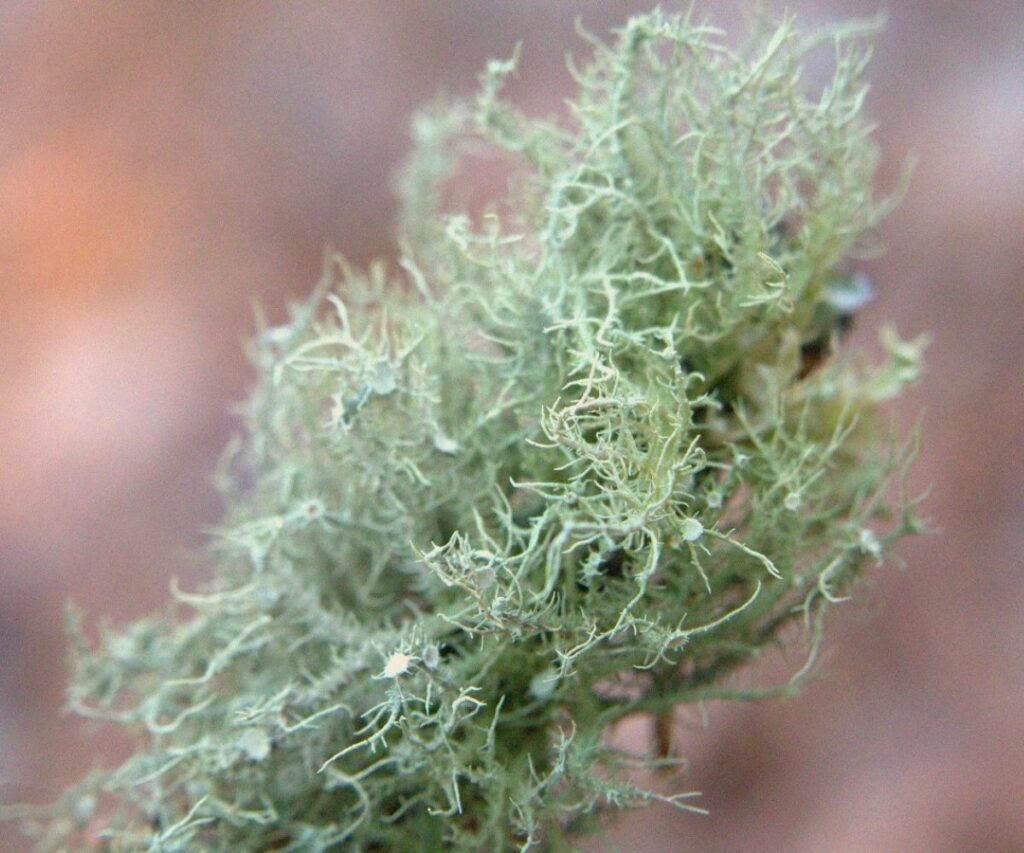
Usnea is a beautiful lichen. It hangs pendulously from canopy branches high in the sky, with some specimens reaching over five feet long. Of course, not all grow to such a spectacular size. The ones in my area are usually small, sprouting from twigs in tufty eruptions measuring just a few inches across.
It’s easy to see why usnea lichen’s nicknames include “old man’s beard,” “witches’ hair,” and “forest beard.” It might grow outward like a child’s cowlick when young, but older lichens sport a more distinguished mane that sags under its own weight exactly like facial hair.
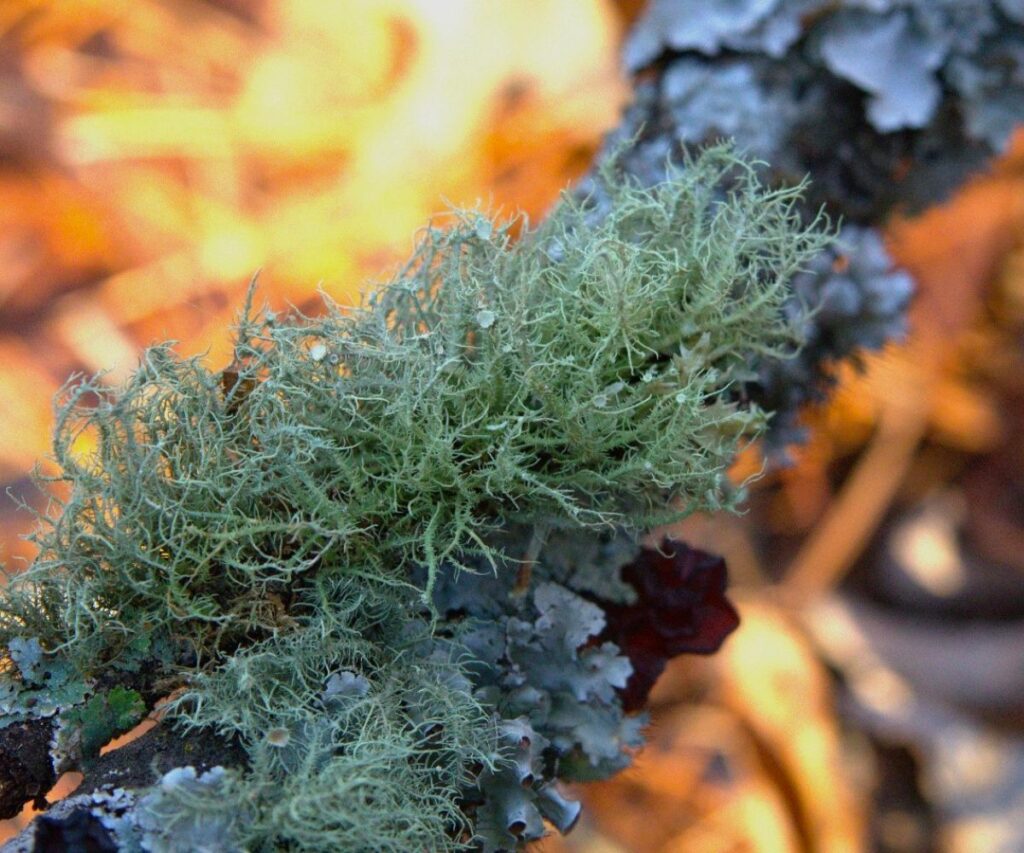
Here’s what to look for:
- Color: Usnea is distinctly green, but various species may be tinted gray, yellow, beige, or brown. Specimens may be light, dark, bright, or subtle. Coloring varies with environmental conditions and moisture level, with dry lichens usually presenting less vibrantly.
- Texture: Usnea can be soft and silky or tough and wiry. Dry specimens are always rougher than fresh specimens, and older lichens may be tougher than younger counterparts of the same species.
- Shape: Usnea is a fruticose lichen characterized by shrubby growth resembling a coral or bush. Different species will be shaped differently, with some resembling little trees and others embracing the “forest beard” moniker.
- Apothecia: Usnea has a fun propensity to mix things up and can reproduce sexually or asexually. During sexual reproduction, usnea sprouts apothecia, which look like small discs or cups at the end of their tendrils.
- Attachment: Usnea attaches to its substrate at a single point. Other lichens and moss attach at numerous points or all over, but the entire usnea structure grows from just one branch.
Species Variation
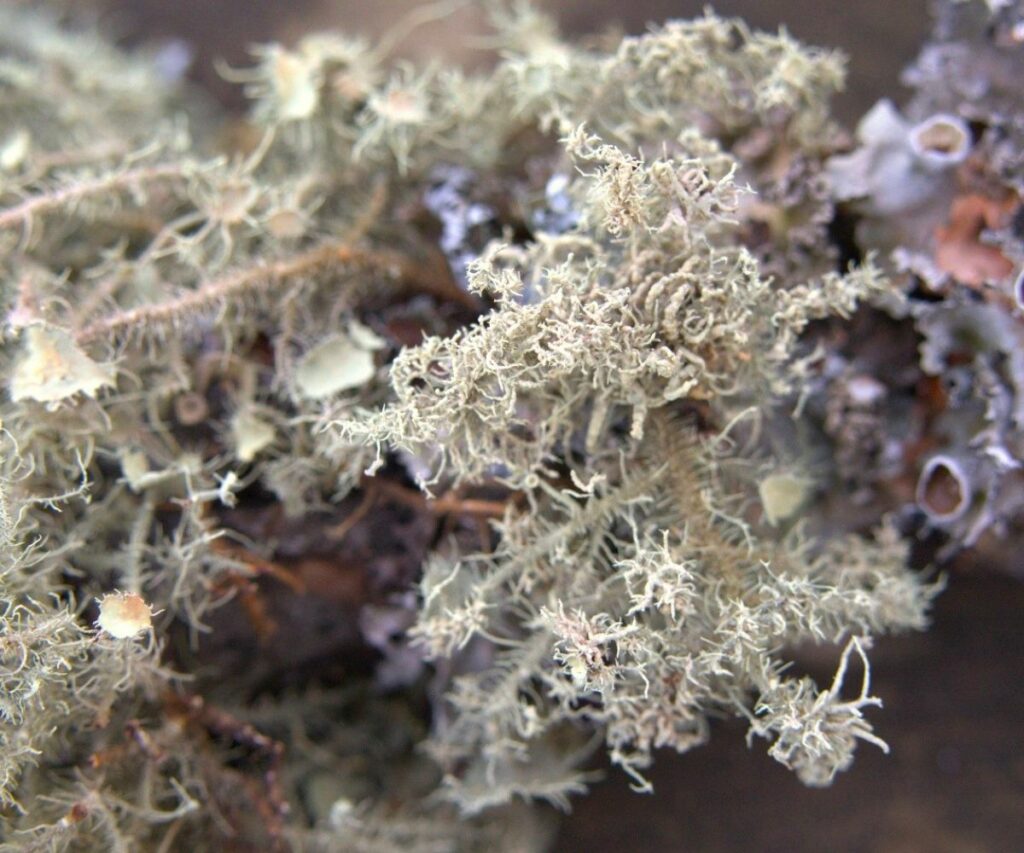
As of right now, there are around 360 species belonging to the genus Usnea. All share certain characteristics, but they can vary widely in appearance.
Usnea species you might encounter in different North American regions:
- Usnea longissima: Truly resembling an old man’s beard, U. longissima is light yellow-green and drapes majestically over the branches of conifer trees. It rarely features apothecia and is most common in the Pacific Northwest.
- Usnea strigosa: Short and stubby, U. strigosa resembles coral more than beard hair and prefers oaks to pines. It features numerous large apothecia and grows throughout the southern and eastern US.
- Usnea cavernosa: Large and droopy, U. cavernosa is common at high elevations in humid mid- and southwest mountainous areas. Its tendrils are thin and stringy but smooth, and it prefers spruce trees.
It is challenging to positively identify an usnea lichen by species. Without a microscope, an extensive botanical education, and a working knowledge of the genus, we’re left floundering in the dark.
Fortunately, all is not lost. We can still look at a lichen’s overall characteristics to determine with certainty that the specimen in question is usnea. If so, then it is medicinally useful. While exact composition may vary between species, all usnea contain the beneficial usnic acid we’re after.
Some species are rare and tender, while others are more prolific and hardier. Depending on where you live, you may find dozens of different kinds growing in the same forest.
So, even if two fruticose lichens differ dramatically, pay attention to their characteristics — they may both be usnea!
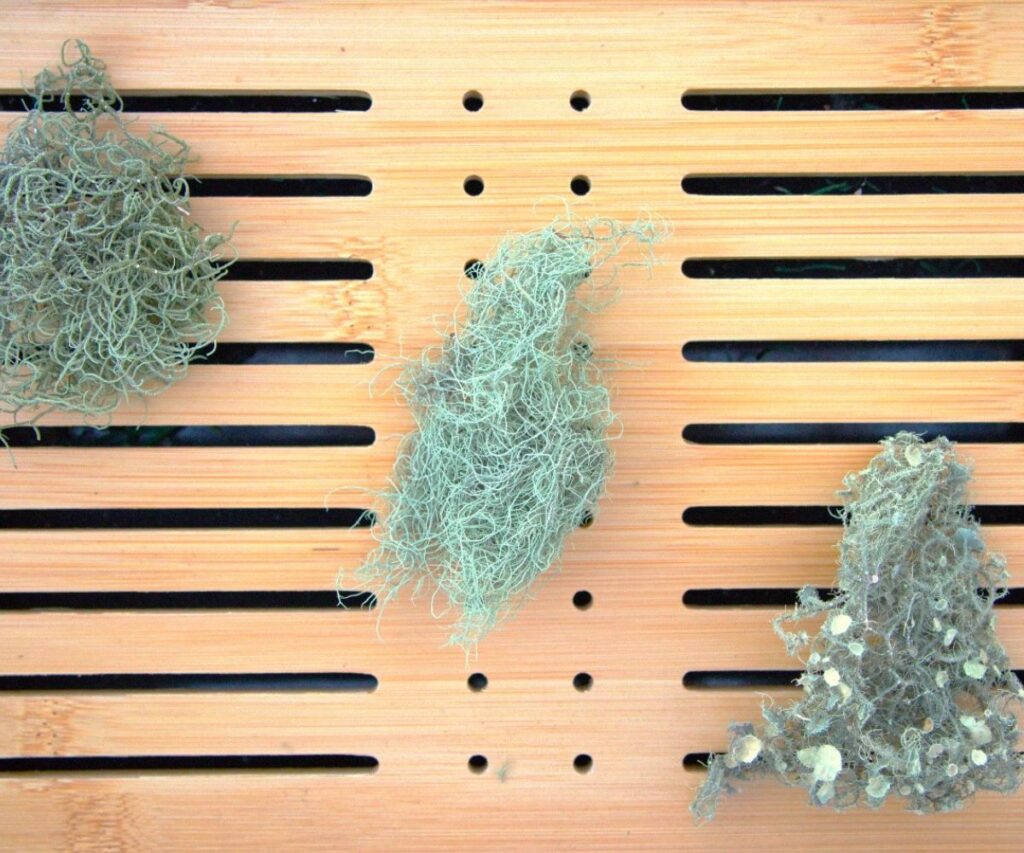
The Core Rule
There is one thing that all usnea species have in common: their white inner core.
Other mosses and look-alike lichens feature insides that match their outside color. However, usnea has a white core beneath its outer green flesh that looks like a piece of cord.
The cord is sometimes elastic in fresh specimens, springing back when pulled. In older or dried specimens, it loses this elasticity. When you find what you believe to be usnea, peel back the sheath around a thick section of its shaft to check for the cord.
Every single usnea species has a white core inside. If there’s no white core, it’s not usnea. More to the point, as far as we know, only usnea species have a white core. That means if it’s white inside, you have found usnea.
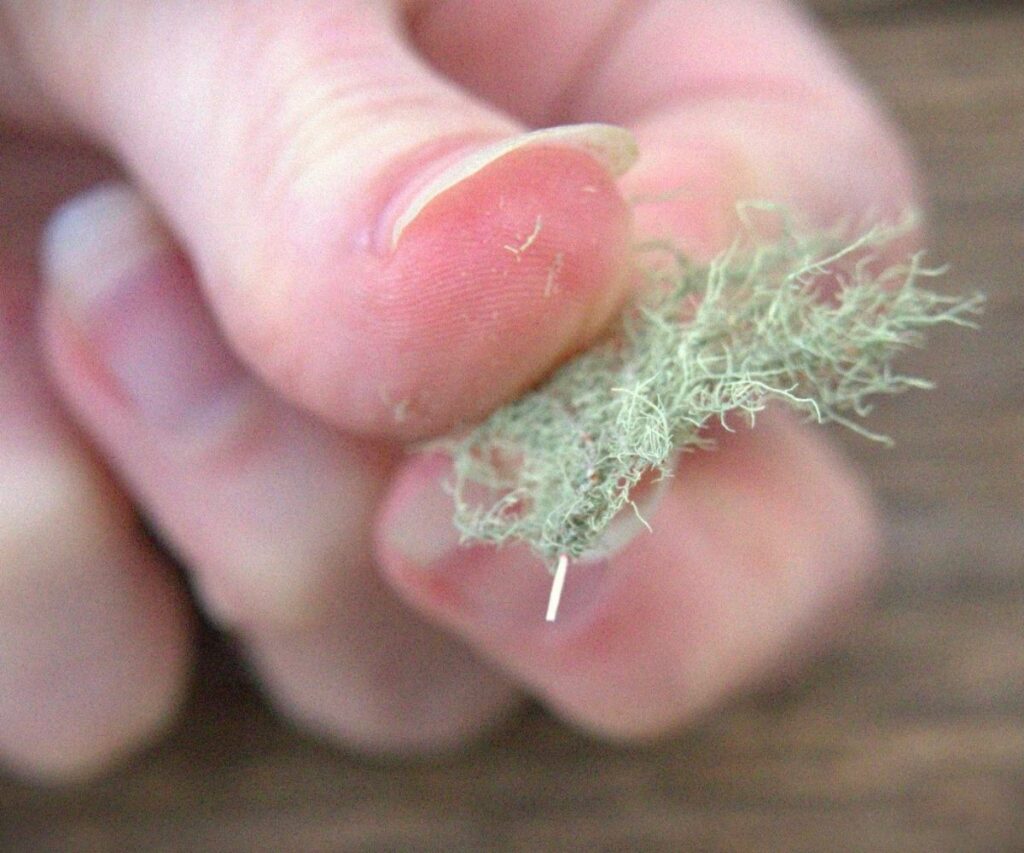
Habitat and Season
Usnea lichen grows across the world, and multiple different species populate every single state in the US.
It isn’t easy to pinpoint an exact habitat because each species is so variable, but all have some things in common. Usnea lichen prefers high-moisture, old-growth deciduous or hardwood forests. It can populate any tree, with some species preferring conifers and others preferring hardwoods, like oak and beech.
It seldom, if ever, grows on rocks or soil. Instead, it often grows on branches with other lichens, fungi, or algae.
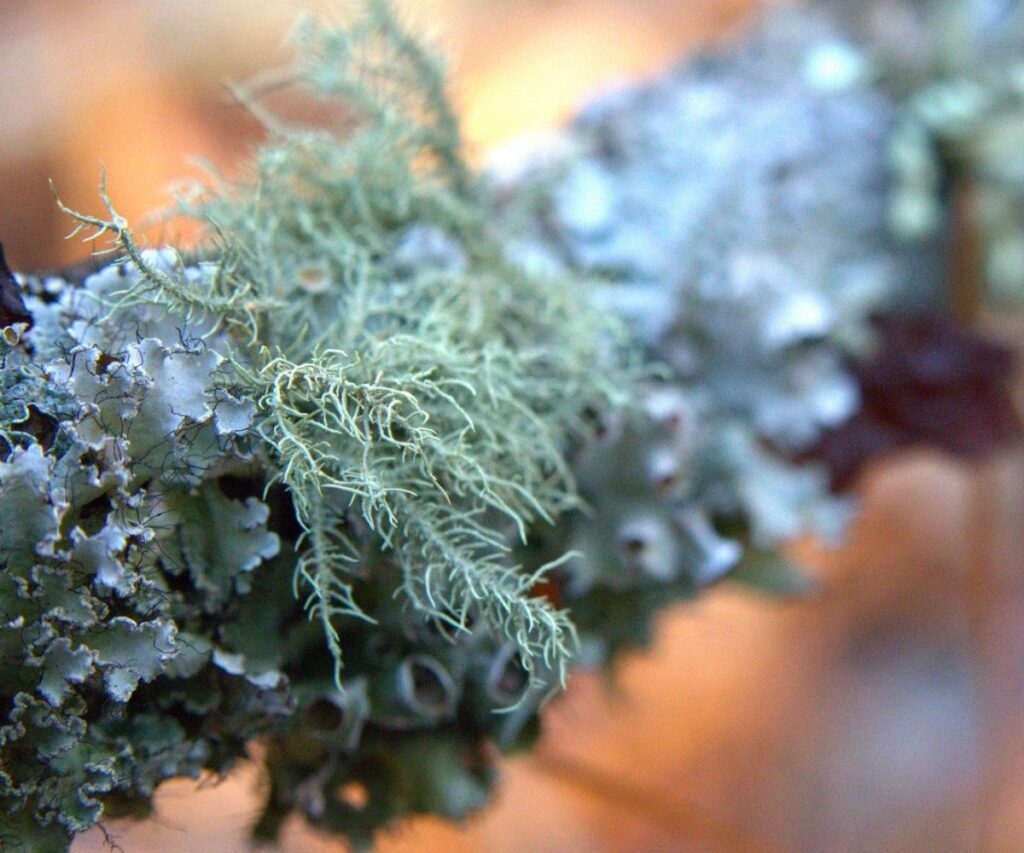
Usnea has no specific season. It grows incredibly slowly and takes many years, sometimes decades, to become sizeable. The exact growth rate varies between species and location. It depends mainly on environmental factors like moisture and air quality, but some grow less than a millimeter each year.
Despite these facts, I always find more usnea lichen growing around the spring. After the snow melts and during heavy rains, water is more abundant, which may cause a spike in growth.
Growth Conditions
Like all lichens, usnea is a botanical centaur. It is a combination of fungi and algae that grow together in a symbiotic relationship to form an entirely new organism.
Usnea lichen belongs to the family Parmeliaceae. Species are always a combination of fungi from the phylum Ascomycota and algae from the phylum Chlorophyta.
The fungus forms the basal fruticose structure, while the alga forms a protective and nutritive barrier through which the union feeds.
The environment must support both the fungus and the alga that form usnea. Water is critical here. Usnea is common near rivers and lakes and fails to thrive in dry conditions.
Usnea cannot grow in areas that are highly polluted.
Like many lichens, it absorbs chemicals like a sponge and dies once it becomes inundated with toxins. It is sensitive enough to be a highly reliable indicator of good air quality.
Unfortunately, this means its population is quickly diminishing. While it may be able to grow in all sorts of elevations and climates, it cannot grow without clean air.
Once considered an incredibly common lichen, usnea is slowly beginning to disappear as pollution becomes more rampant.
Some species are endangered in much of North America, including U. longissima. It has disappeared entirely from many areas in Europe and Scandinavia.
Sustainable Harvesting
Despite its wide range, a global increase in air pollution could spell dire consequences for usnea lichen. Because it is becoming so rare, it is imperative to harvest this lichen sustainably.
The first rule of sustainable harvesting is to collect usnea only from fallen twigs and branches. Never pick usnea from a living tree. Often, the wind blows usnea off branches, and you’ll find clumps of it on the ground. Collecting these rudderless specimens is ideal since they will no longer grow.
However, only collect as much as you need for your desired application. Usnea often reproduces through fragmentation, so windblown lichens may still serve to repopulate an area. Even dead specimens are integral to the woodland ecosystem, acting as fertilizer and food for forest creatures.
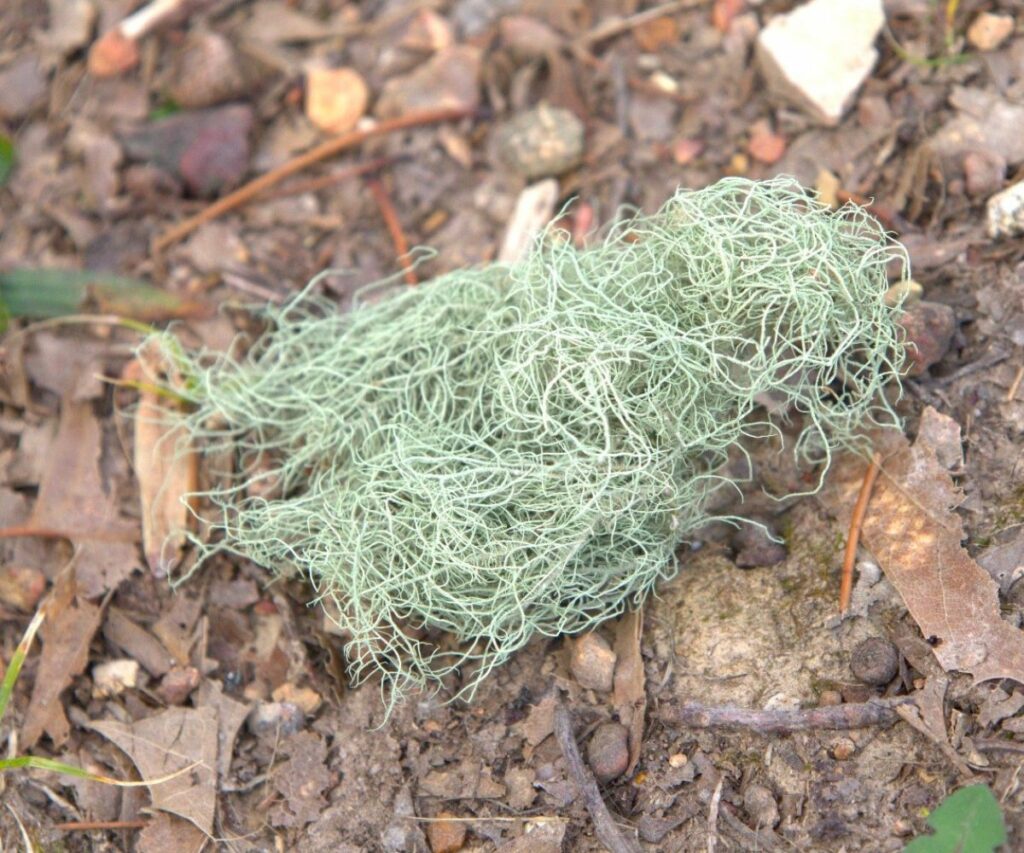
Play It Safe
Keep in mind that usnea lichen is highly absorbent. Any toxic materials nearby, including naturally occurring toxins and heavy metals, will contaminate it.
You want to avoid ingesting these, so only forage usnea lichen in places free of contamination and pollution.
Recognizing Common Look-Alikes
Ramalina
The Ramalina genus contains many green fruticose lichens. Numerous Ramalina species produce apothecia and form long, thin hairs that resemble usnea.
The Ramalina species I find usually have thicker, flat hairs and a more compact structure than usnea. Ramalina also does not discriminate regarding substrate; you can find them on wood, rock, and even sometimes on soil.
Despite their growth habits, the two can be hard to distinguish without peeling back the outer layer of flesh. Inside a Ramalina, there is no white core.
Alectoria
Alectoria species are fruticose lichens of the family Parmeliaceae with a wide distribution. They are relatively common throughout North America, South America, and Europe.
Alectoria prefers to grow on conifers in humid forests but may grow on bark, wood, rock, and soil. While some species are branched, others are more rotund with thick cords and few branches.
Alectoria lichens are often green but may be brown, streaked, grayish, or blackish. They usually reproduce asexually and rarely feature apothecia. They also lack usnea’s white inner cord.
Spanish Moss
It’s easy to mistake Spanish moss for usnea. This imposter is known as Tillandsia usneoides in the scientific community, with usneoides literally translating to “resembling usnea.”
But don’t be fooled. Spanish moss is not a lichen. It’s not even a moss — it’s a perennial bromeliad plant belonging to the same family as pineapple.
However, it hangs in long, beard-like strands from tree limbs just like usnea.
Spanish moss may grow larger than usnea and sport longer strands, sometimes up to 25 feet. The color is rarely as bright as usnea, and this plant lacks the delicate coral structure that makes our lichen so loveable.
If ever in doubt, peel open a strand. Spanish moss will not have a white cord beneath its outer layer as usnea does.
Usnea lichen is a beautiful botanical masterpiece with many health and wellness benefits. Now that you know how to identify this lovely lichen, it’s time to hit the trail and start foraging some today!


Usnea californica has a pinkish core, rather than white. It’s a distinguishing characteristic.